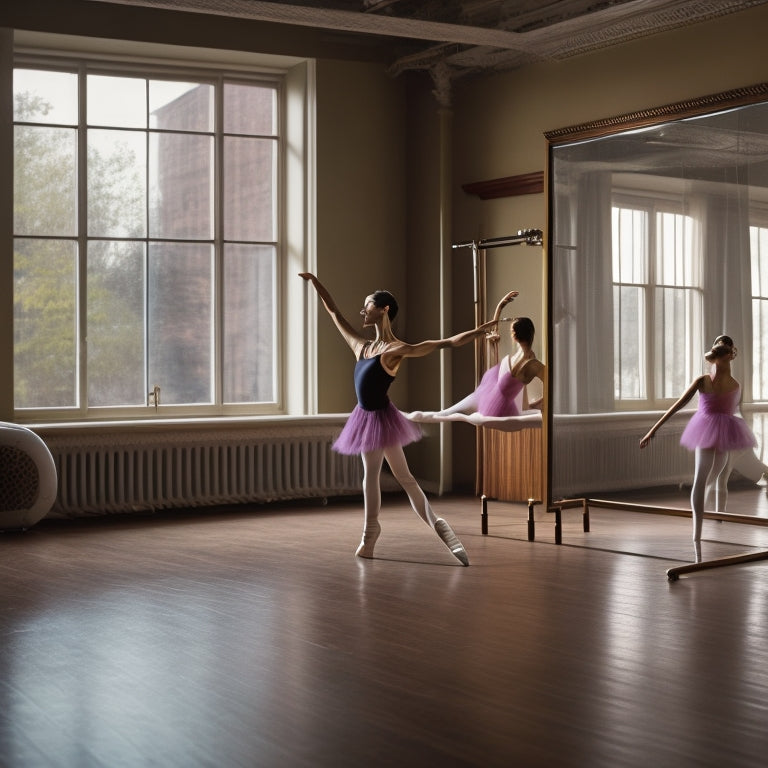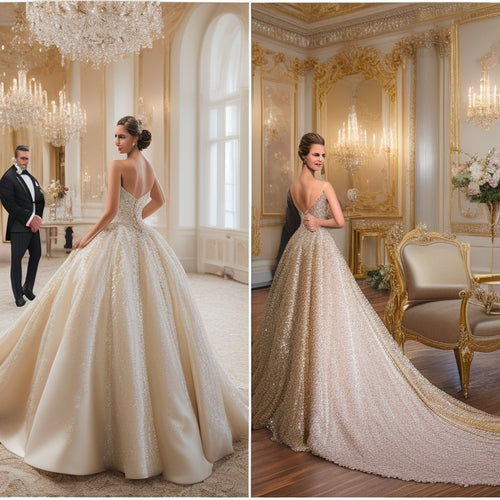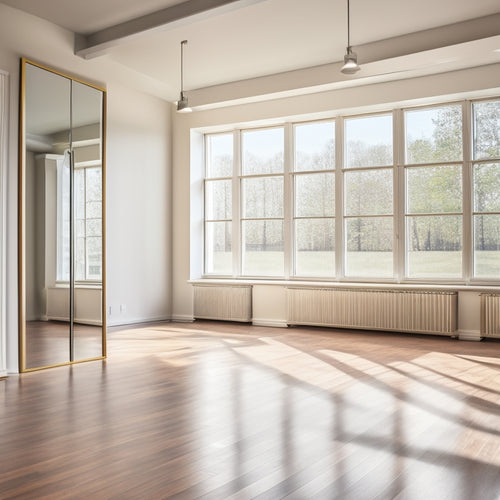
How High Is a Ballet Bar?
Share
You'll typically find a ballet bar standing between 35 and 47 inches above the floor, a range designed to accommodate dancers of varying heights and promote comfortable exercises with proper posture and alignment. This standard height allows for comfortable grip, ideal body alignment, and freedom of movement. However, factors like age, body proportions, and ballet style can influence the ideal bar height. As you explore the world of ballet, you'll discover the nuances of bar height and how it affects your technique, safety, and overall dance experience.
Key Takeaways
• A standard ballet bar typically ranges from 90 to 120 centimeters (35 to 47 inches) above the floor to accommodate dancers of varying heights.
• The ideal bar height depends on factors such as dancer's height, body proportions, and exercise type, making adjustable bars necessary.
• For adult ballet classes, the average bar height ranges from 32 to 42 inches, promoting comfortable grip, ideal body alignment, and freedom of movement.
• For children, the ideal barre height is essential for promoting proper posture, confidence, and muscle memory development, and should be adjusted accordingly.
• The bar height may need to be adjusted for injuries, using blocks and risers for support, and considering individual proportions and ergonomic positioning.
Typical Height Range for Ballet Bars
A standard ballet bar typically ranges in height from 90 to 120 centimeters (35 to 47 inches) above the floor, allowing dancers of varying heights to comfortably perform exercises and movements.
As you prepare for your ballet class, you'll want to confirm the bar is at an ideal height for your body. When the bar is correctly positioned, you'll be able to maintain proper posture and alignment, which is essential for executing movements safely and effectively.
Factors Affecting Ballet Bar Height
When choosing a ballet bar, you'll need to take into account factors that impact its ideal height. You'll want to think about the dancer's height range, as a bar that's too high or too low can affect technique and comfort.
Additionally, you'll need to determine whether an adjustable bar is necessary to accommodate multiple users or varying exercises.
Dancer's Height Range
Your height greatly impacts the ideal ballet bar height, as a taller dancer requires a higher bar to maintain proper alignment and prevent strain on the back and legs.
As a dancer, your body proportions play a significant role in determining the ideal bar height.
Here are three key factors to take into account:
-
Ideal physique: A dancer with an ideal physique, characterized by long legs and a short torso, may require a higher bar to maintain proper alignment.
-
Leg length: Dancers with longer legs require a higher bar to prevent strain on their legs and back.
-
Torso length: Conversely, dancers with shorter torsos may need a lower bar to maintain proper posture.
Bar Adjustable Options
You'll find that adjusting the ballet bar to accommodate your individual needs is key, as fixed bars can be limiting and even detrimental to proper technique.
With adjustable bars, you can customize the height to suit your body, allowing for ideal alignment and movement. Look for bars with advanced mechanisms that offer smooth, incremental adjustments, ensuring a seamless shift between heights.
This customization allows for a more comfortable and effective practice, especially for dancers with varying heights or injuries. By having control over the bar's height, you can focus on perfecting your technique, rather than compensating for a fixed bar.
With the right adjustable bar, you'll experience the freedom to move and express yourself with confidence.
Studio and Age Group Considerations
Different studios and age groups require varying ballet bar heights to accommodate unique teaching styles and student needs.
As you set up your studio, consider the following factors:
-
Studio Layout: Position the bar to maximize floor space and facilitate smooth changes between exercises.
-
Age Segregation: Adjust the bar height according to the age group you're teaching. For example, younger students may require lower bars, while older students may need higher ones.
-
Instructor Preference: Some instructors prefer a higher bar to emphasize proper posture, while others prefer a lower bar to focus on footwork.
Different Heights for Various Ballet Styles
When exploring various ballet styles, from classical to contemporary, ballet bar heights are adjusted to facilitate specific techniques and movements.
As you investigate different styles, you'll find that bar heights vary to accommodate unique requirements.
For instance, in Ballet Fusion, which combines classical ballet with modern and contemporary techniques, the bar is often set at a lower height to allow for more fluid, expressive movements.
In Contemporary Expressions, the bar may be set higher to emphasize powerful, weighted movements.
You'll find that the bar's height is carefully considered to support the specific demands of each style, enabling you to move freely and expressively.
Average Height for Adult Classes
When considering adult ballet classes, the average bar height is typically set between 32 and 42 inches, allowing for a comfortable grip and ideal body alignment. As you take your place at the barre, you'll notice that this height range accommodates a variety of adult preferences, ensuring that dancers of different statures can move freely and focus on their technique.
Concerning class dynamics, this height range also promotes a sense of community, as dancers can easily interact and support one another. Here are three key benefits of this average bar height:
-
Comfortable grip: Allows for a secure hold, reducing fatigue and strain.
-
Ideal body alignment: Enables proper posture and alignment, essential for preventing injuries.
-
Freedom of movement: Provides ample space to execute movements without feeling restricted.
Recommended Height for Children
Setting the barre at the right height for children's classes is essential, as it helps young dancers maintain proper posture, build confidence, and develop muscle memory. As a ballet instructor, you want to make sure that your students are comfortable and able to focus on their technique. Here's a general guide for recommended barre heights based on age and average height:
| Age Range | Average Height | Recommended Barre Height |
|---|---|---|
| 5-7 years | 43-48 inches | 24-26 inches |
| 8-10 years | 48-54 inches | 26-28 inches |
| 11-13 years | 54-60 inches | 28-30 inches |
| 14+ years | 60+ inches | 30-32 inches |
Adjusting Bar Height for Injuries
As you adapt your teaching methods to accommodate students with injuries, you'll need to adjust the barre height to alleviate discomfort and prevent further strain. This is important for injury prevention and management of chronic pain. By adjusting the barre height, you can help reduce discomfort and promote a safe and comfortable learning environment.
Here are three key considerations for adjusting barre height for injuries:
-
Assess the injury: Understand the nature and severity of the injury to determine the necessary adjustments.
-
Adjust for comfort: Lower or raise the barre to a comfortable height that allows the student to maintain proper posture and alignment.
-
Monitor and adjust: Continuously monitor the student's comfort and adjust the barre height as needed to ensure a safe and effective learning experience.
Using Blocks and Risers for Support
You can use blocks and risers to provide additional support and stability for students, particularly those with injuries or limitations, by placing them strategically under their hands or feet to achieve ideal alignment and balance. This allows students to focus on their technique without compromising their safety or comfort.
The portability of blocks and risers is especially important, as they can be easily moved or rearranged to accommodate different students' needs. By using these tools, you can offer stability benefits that enhance overall performance and reduce the risk of injury.
Ballet Bar Height in Professional Studios
In professional studios, ballet bars are typically installed at a height that allows dancers to stand with their arms relaxed by their sides, with their elbows slightly bent and their hands grasping the bar at a comfortable distance from their bodies. This height consideration is rooted in ballet history, where studio design played a significant role in creating an ideal learning environment.
Here are three key factors influencing ballet bar height in professional studios:
-
Dancer comfort: The bar should be at a height that allows you to stand comfortably, with minimal strain on your back and shoulders.
-
Proper alignment: The bar should support your body in proper alignment, with your shoulders down and away from your ears.
-
Effective exercise: The bar should be at a height that enables you to execute exercises efficiently, without compromising your form or technique.
Measuring and Marking the Ideal Height
When preparing to measure and mark the ideal height of your ballet bar, you'll need to take into account the dancer's individual proportions, factoring in their arm length and hand size.
You'll also need to take into consideration the bar's height in relation to the floor, ensuring a comfortable and ergonomic position.
Measuring the Dancer
Stand with your feet shoulder-width apart, parallel to each other, and your arms relaxed by your sides, preparing to determine the ideal height of your ballet bar. To measure yourself, you'll need to analyze your posture and body alignment. This is essential in finding the perfect bar height that allows for ideal movement and freedom.
Here's what to do:
-
Maintain proper posture: Engage your core, lengthen your spine, and relax your shoulders.
-
Check your body alignment: Make sure your ears, hips, and ankles are in a straight line.
-
Take note of your arm length: Measure from the top of your shoulder to your wrist, as this will impact your bar height.
Bar Height Considerations
Now that you've assessed your posture and body alignment, you'll use your arm length to determine the ideal bar height, which should allow your arm to bend at a 90-degree angle when grasping the bar. This is important for maintaining proper bar etiquette and avoiding discomfort or strain.
From a dance psychology perspective, having control over your bar height can boost your confidence and freedom of movement. Measure the distance from the floor to the crease of your wrist when your arm is bent at a 90-degree angle. This will give you the ideal height for your ballet bar.
Marking the Ideal Spot
Measure the distance from the floor to the crease of your wrist with a ruler or tape measure to pinpoint the ideal spot for your ballet bar. This fundamental step in ballet fundamentals guarantees a comfortable and effective practice.
To mark the ideal spot, follow these steps:
-
Record the measurement: Take note of the distance from the floor to the crease of your wrist.
-
Transfer the measurement: Mark the ideal height on the wall or ballet bar stand using a pencil or marker.
-
Double-check the spot: Confirm the marked spot is at a comfortable height, allowing you to maintain proper posture and execute movements with ease.
Frequently Asked Questions
Can I Use a Ballet Bar in a Small Home Exercise Space?
You can definitely use a ballet bar in your small home exercise space, but be mindful of space constraints and cleverly incorporate it into your home decor to maximize functionality and aesthetic appeal.
Are There Any Portable Ballet Bar Options Available?
You'll find portable ballet bar options that fit your lifestyle, including space-saving designs and travel cases, allowing you to practice freely wherever you go, without sacrificing your exercise routine.
Can I Attach a Ballet Bar to a Wall Permanently?
'When attaching a ballet bar to a wall permanently, you'll need to guarantee drill safety, assess wall stability, choose the right anchor types, consider load capacity, and explore mounting options to secure your bar and dance freely.'
Are Ballet Bars Suitable for People With Disabilities?
You'll find that ballet bars can be adapted for people with disabilities when using accessible equipment and implementing adaptive modifications, such as adjustable heights, to promote inclusivity and freedom of movement.
Can I Use a Ballet Bar for Other Forms of Exercise?
You can utilize a ballet bar for diverse exercises, incorporating cross training, yoga modifications, and dance fusion to enhance strength and flexibility, ultimately revealing new possibilities for your fitness journey.
Related Posts
-

7 Formal Dance Dresses for Black-Tie Events
For your next black-tie event, consider these seven stunning formal dance dresses that promise to turn heads. A class...
-

Tips and Tricks for Collapsible Ballet Bar Installation
To install your collapsible ballet bar, start by gathering essential tools like a drill, level, and measuring tape. M...
-

Get Crafty! Dance SVG Digital File
Elevate your DIY projects with the Get Crafty! Dance SVG Digital File, featuring 10 unique designs tailored for dance...


